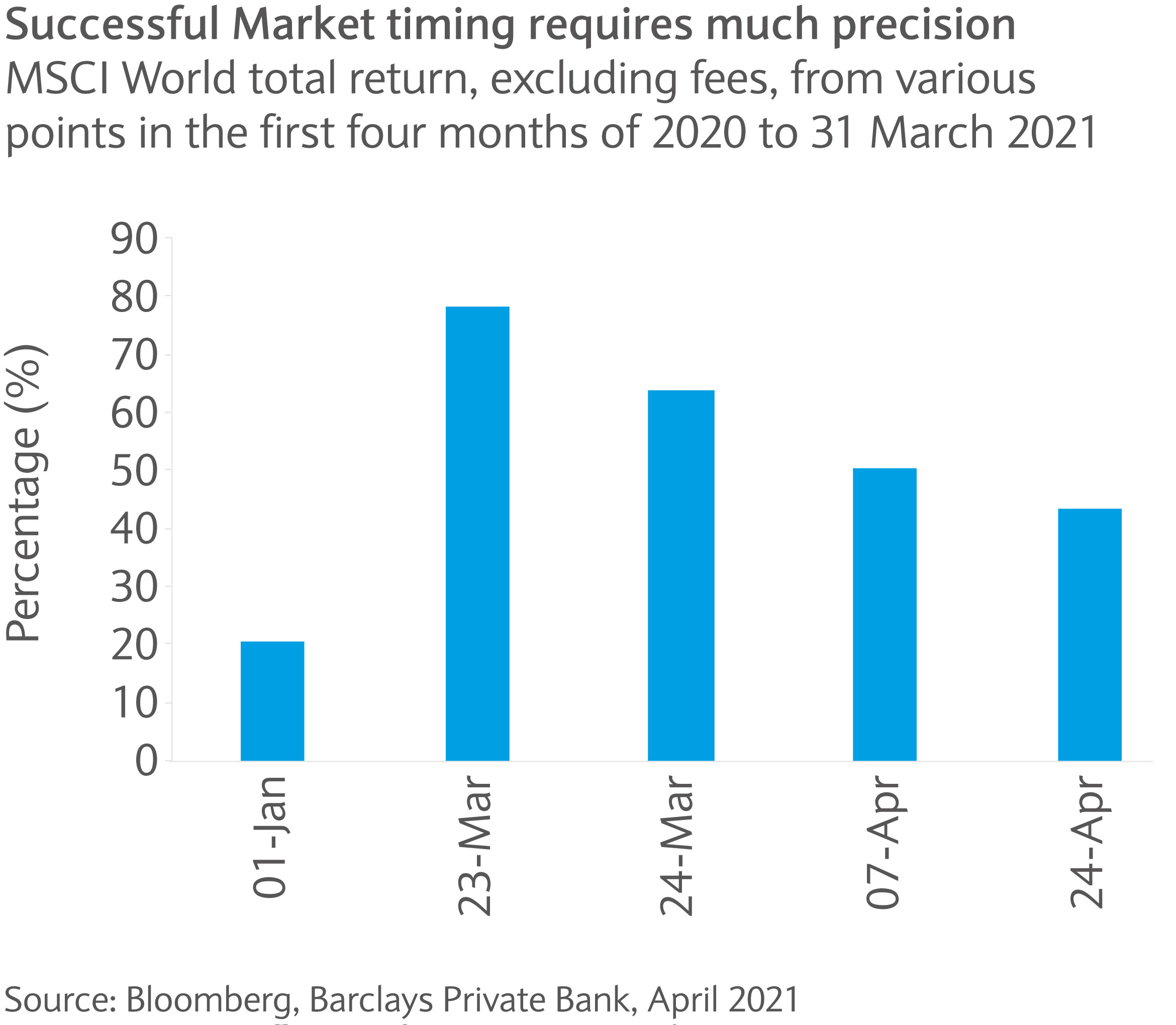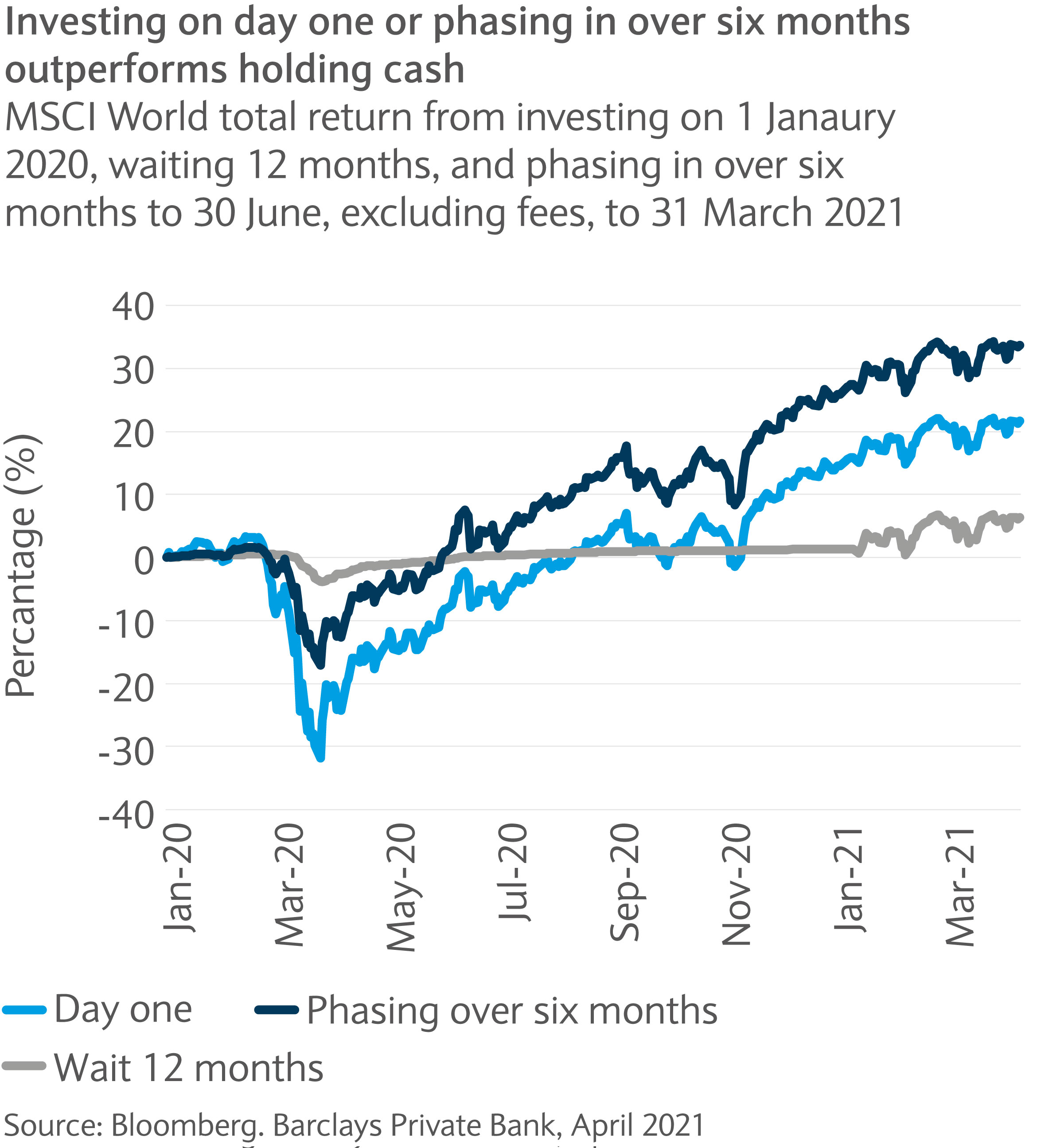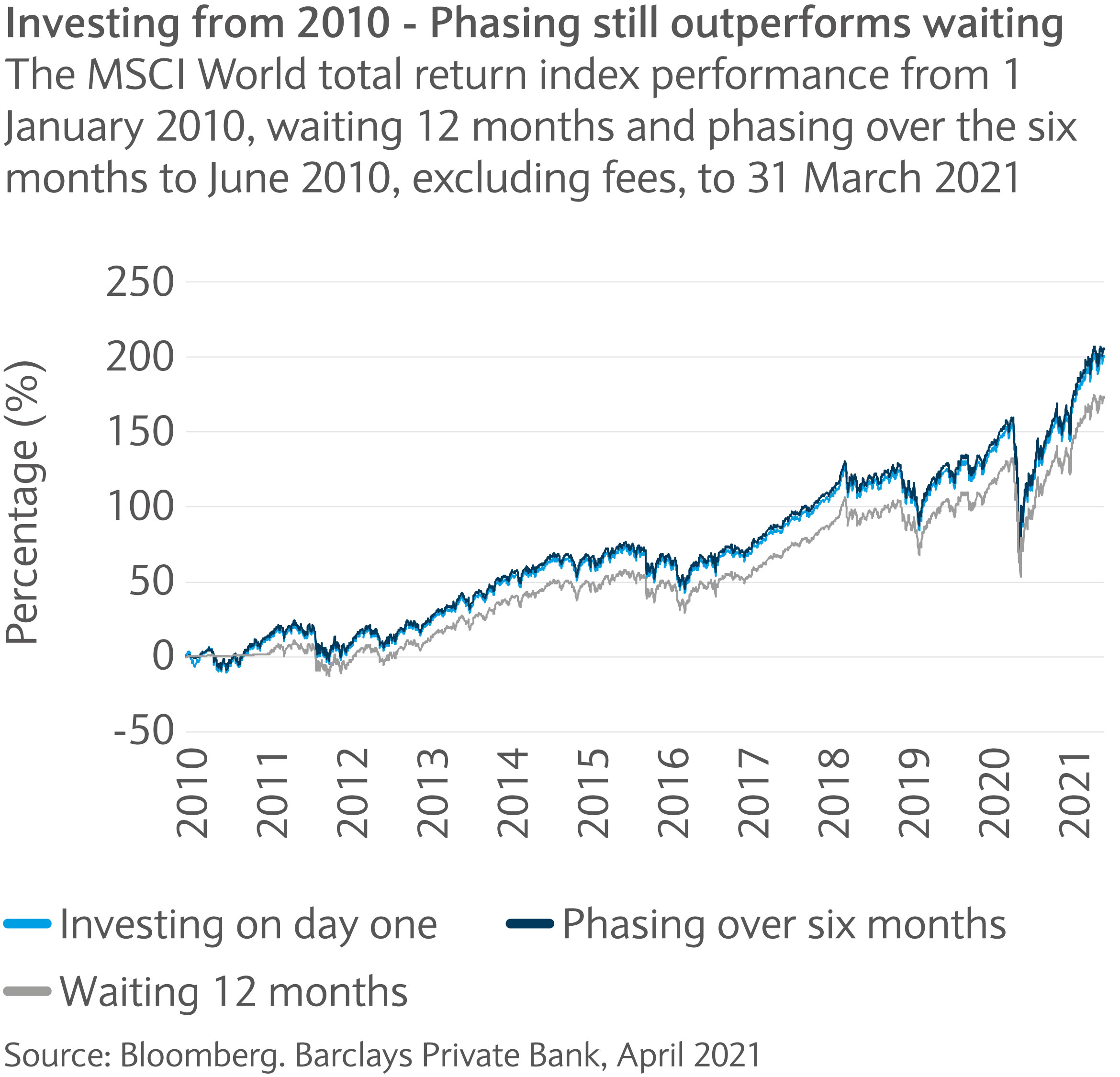
Market Perspectives May 2021
Investor sentiment remains buoyant, despite accelerating Indian COVID-19 cases, with encouraging economic signs in the US and China.

07 May 2021
By Alexander Joshi, London UK, Behavioural Finance Specialist
You’ll find a short briefing below. To read the full article, please select the ‘full article’ tab.
Timing the market is a difficult sport. Phasing in investments over an extended period may be more sensible. Getting invested and maximising the time that your capital has in the market may provide the best chance of meeting your long-term goals.
There is a cost to holding cash – the erosion of real value due to inflation – which increases with the rate of inflation and the time period held for. At present rates, holding a sum in cash for 10 years would erode your wealth by 10%, requiring a return of 26% just to regain the original purchasing power1.
While recognising the costs of waiting too long, some investors may want to time their entry into the market, in an attempt to prevent potential losses and capitalise in the short term from current or impending events (which may or may not materialise). Market timing is however a difficult sport.
The difficulties of market timing
Last year was particularly volatile. The MSCI World index started 2020 at 2,358, rising to 2,431 at its 19 February peak, before falling 34% to its 23 March low of 1,602. A spectacular rise of 68% then took it to 2,690 on the last trading day of the year, ending up 14% on the year. Quite an eventful ride.
Investing on 1 January 2020 provided a total return, including dividends, of 22% before fees of at the end of March 2021. Timing the market perfectly meant investing at the point of maximum drawdown, on 23 March, and returned 78%. Given the sharpness of the pullback, timing the entry point produced returns over four-times larger than those of getting invested on 1 January (see chart).

In hindsight, waiting and getting invested at the low makes perfect sense. Executing this is extremely difficult:
Timing the market low involves acting quickly; waiting just a day from the low and investing on 24 March reduced the additional returns to 43% from 58%. Waiting a fortnight would cut this bonus to 30%, and by a month cuts it to 23%.
The danger of staying in cash
There are periods where holding cash would outperform being invested, though the risk is missing out on participating in a market recovery. How would an investor who decided to sit out the uncertainty of last year and wait before investing have fared?
Holding fire last year and investing on the first day of this year returned 6% to the end of March, much lower than being invested from day one 2020 (see chart).

One could point to a scenario of waiting less and getting invested on 1 July 2020, avoiding the downturn but capturing more of the recovery. However, the correction, and speed of it, seen last year and equally impressive recovery is a low probability event.
Markets are much more likely to rise with small corrections along the way, making waiting costly. So, such a strategy makes sense only with the benefit of hindsight.
Phasing in investments has merits
One way of entering into the markets for those with concerns may be to phase entry. Entering according to defined rules is a sensible approach, with a common one to split up a lump sum into equally sized investments made at regular intervals over a given period.
Phasing in investments may help nervous investors, dampening the impact of volatile periods through an average entry price over the phasing period.
An investor phasing their investment in 2020 into six equally sized trades at the start of the month, from January to June, would have experienced approximately half of the maximum drawdown versus the day one investor. Due to the lower entry points, phasing would have returned 34% to 31 March 2021, compared with 22% for the day one investor.
The last decade: finding a more ‘representative’ year
When looking at the dispersal of annual returns for stocks and bonds there is no such thing as a representative year in investing2. Going back a decade to 2010, as markets were starting to recover from the great financial crisis, we examine the impact of phased investment on returns over the following decade.
Investing in equities on day one 2010 produced a gross nominal annual return of 12%, whereas phasing over the first six months returned 14%, and at the end of March these returns would be 201% and 206% respectively – a small relative improvement. More striking is the impact that waiting 12 months to get invested made. Waiting until the start of 2011 to get invested lowered the gross return to 173% as at 31 March 2021 (see bottom chart).

Staying invested often pays off
As with waiting, the success of phasing versus getting invested on day one is governed by the market performance in that given year. Last year it reduced the volatility experienced while boosting returns, whereas in 2010 the additional benefits were muted.
Given the historical long-term direction of markets has been up and the power of compounding, it pays to invest sooner rather than later. Waiting for a more opportune entry point for getting invested has risks.
We believe that investors maximise the chances of reaching their financial goals by investing with a long-term perspective in a diversified portfolio comprised of quality companies. While markets can be volatile, putting money to work quicker increases an investor’s investment horizon, maximising the chances of receiving returns closer to the long-term averages, which have been better than cash.
For investors who may have concerns about getting invested in markets, phasing investments in gradually might be worth considering.

Investor sentiment remains buoyant, despite accelerating Indian COVID-19 cases, with encouraging economic signs in the US and China.
This communication:
Any past or simulated past performance including back-testing, modelling or scenario analysis, or future projections contained in this communication is no indication as to future performance. No representation is made as to the accuracy of the assumptions made in this communication, or completeness of, any modelling, scenario analysis or back-testing. The value of any investment may also fluctuate as a result of market changes.
Barclays is a full service bank. In the normal course of offering products and services, Barclays may act in several capacities and simultaneously, giving rise to potential conflicts of interest which may impact the performance of the products.
Where information in this communication has been obtained from third party sources, we believe those sources to be reliable but we do not guarantee the information’s accuracy and you should note that it may be incomplete or condensed.
Neither Barclays nor any of its directors, officers, employees, representatives or agents, accepts any liability whatsoever for any direct, indirect or consequential losses (in contract, tort or otherwise) arising from the use of this communication or its contents or reliance on the information contained herein, except to the extent this would be prohibited by law or regulation. Law or regulation in certain countries may restrict the manner of distribution of this communication and the availability of the products and services, and persons who come into possession of this publication are required to inform themselves of and observe such restrictions.
You have sole responsibility for the management of your tax and legal affairs including making any applicable filings and payments and complying with any applicable laws and regulations. We have not and will not provide you with tax or legal advice and recommend that you obtain independent tax and legal advice tailored to your individual circumstances.
THIS COMMUNICATION IS PROVIDED FOR INFORMATION PURPOSES ONLY AND IS SUBJECT TO CHANGE. IT IS INDICATIVE ONLY AND IS NOT BINDING.
The price of holding cash, April 2021, Barclays Private BankReturn to reference
Taking the plunge, June 2020, Barclays Private BankReturn to reference